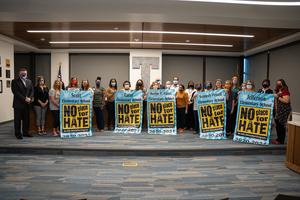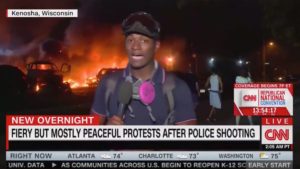Parents Should Pay Attention When the ADL Speaks
While outcry last week to The View host Whoopi Goldberg’s controversial Holocaust comments was fast and largely furious, response from the Anti-Defamation League (ADL) was especially interesting and one of which parents should especially take note.
Why should parents pay attention? Very simply, ADL sponsors a “No Place for Hate” anti-bullying/anti-racism program that targets grade levels PreK-12 and is used, per its web site, in 1,800+ schools across the U.S. With its controversial curriculum, it could easily be in your school district.

Photo by TISD
My local school district’s proud participation in the ADL-sponsored “No Place for Hate” program first provided awareness of this particular initiative and interest has only grown with further research plus a review of program materials.
This makes the ADL’s response to the Goldberg controversy all the more instructive considering the organization’s perspective is potentially influencing your child’s sense of race, discrimination, sexuality as well as their world view.
Setting the stage – why parents should pay attention
Through No Place for Hate programs, ADL ideology is inserted into American students’ school experience.
Aaron Kliegman of JusttheNews.com offered an interesting take on Whoopi Goldberg’s controversial comments in ADL CEO scolds Whoopi Goldberg for Holocaust gaffe consistent with ADL’s woke redefinition of racism.
Per Kliegman:
Jonathan Greenblatt, chief executive of the Anti-Defamation League (ADL), rebuked Whoopi Goldberg this week for saying the Holocaust was “not about race.” However, Goldberg’s comments were consistent with the ADL’s own controversial redefinition of racism, while Greenblatt’s rebuttal was inconsistent with his own organization’s woke reduction of racism exclusively to skin color.
Remember, Goldberg termed the Holocaust as “white people doing it to white people” contending that the murder of six million Jews was not about race. Greenblatt’s admonishment of Goldberg’s position was noteworthy due to his own organization’s recent redefinitions of racism.
Greenblatt first tweeted “No @WhoopiGoldberg, the #Holocaust was about the Nazis’ systematic annihilation of the Jewish people — who they deemed to be an inferior race. They dehumanized them and used this racist propaganda to justify slaughtering 6 million Jews. Holocaust distortion is dangerous. #ENOUGH.”
He then went on The View the day after the remarks for further discussion with Goldberg and her co-hosts. The New York Post described the segment:
“Whoopi, there’s no question that the Holocaust was about race,” Greenblatt told her.
“Literally, the first page of ‘Maus,’ the book you were talking about yesterday, Whoopi, opens with a quote from Hitler, and literally it says, ‘The Jews undoubtedly are a race, but they are not human,’” he told her.
“Hitler’s ideology was predicated on the idea that … the Jews were a subhuman race. It was a racialized anti-Semitism,” he told her.
“Throughout the Jewish people’s history, they have been marginalized, they have been persecuted, they have been slaughtered, in large part because many people felt they were not just a different religion, but indeed a different race.”
Plot twist
On Feb. 1, the day Greenblatt visited The View, the ADL’s website featured this definition of racism.
Racism: The marginalization and/or oppression of people of color based on a socially constructed racial hierarchy that privileges white people.
And remember, this is the ideology of the ADL-sponsored No Place for Hate program that is currently purported to be used in 1,800+ schools.
“Racism is the belief that a particular race is superior or inferior to another, that a person’s social and moral traits are predetermined by his or her inborn biological characteristics. Racial separatism is the belief, most of the time based on racism, that different races should remain segregated and apart from one another.”

Screenshot from CNN via Fox News.
It appears this definition was changed to the “people of color” version on Aug. 7, 2020. What might have prompted such a change? Perhaps three clues: George Floyd, Black Lives Matter and “mostly peaceful” protests.
The irony of this dust-up is that Goldberg was correct – at least as per the ADL’s own statement. Her “not about race” comment comported with the organization’s then-current definition that positions only “people of color” as racism victims and “white people” as the privileged perpetrators. So to Goldberg’s Jan. 31 point, the German and other European Jews slaughtered in the Holocaust were not “people of color” and therefore, by ADL standards, not victims of racism. Kliegman’s Feb. 1 article was also correct based on the ADL’s posted definition of racism on that day.
But that’s not the end of the story. Akin to the summer of 2020 prompting a revision of ADL’s racism definition in what seemed an effort to pander to Black Lives Matter and associated supporters, Greenblatt and company appeared to similarly act on Feb. 2 with the ADL website once again featuring a new definition of race, an “interim definition,” that states:
Racism (interim definition): Racism occurs when individuals or institutions show more favorable evaluation or treatment of an individual or group based on race or ethnicity. (Prof. Robert Livingston, The Conversation).
The interim definition is accompanied with a link to an op-ed penned by Greenblatt in which he wrote:
“As a case study, take ADL’s definition of racism. A few years ago, ADL updated our definition to reflect that racism in the United States manifests in broader and systemic ways and to explicitly acknowledge the targeting of people of color — among many others — by the white supremacist extremism we have tracked for decades. While this is true, this new frame narrowed the meaning in other ways. And, by being so narrow, the resulting definition was incomplete, rendering it ineffective and therefore unacceptable. It’s true, it’s just not the whole truth. It alienated many people who did not see their own experience encompassed in this definition, including many in the Jewish community.”
He also used the piece to chastise “numerous detractors who seized upon this issue as confirmation of a sinister plot to promote a political agenda or stop fighting antisemitism altogether” and lamented how “with enough outrage and an Internet browser, a zealot can ‘uncover’ a conspiracy in every digital breadcrumb.” How about it being people paying attention and noting message inconsistencies from a source that routinely scolds those with differing points of view?
A significant event can prompt serious reflection or steps to make a needed course change. This may be one of those times for the ADL. Or might we find hypocrisy just revealed itself at an inopportune moment? Or was this latest definition change another act of pandering in response to perhaps a longtime, deep-pocketed donor base realizing that today’s woke ideology prefers positioning white people as perpetual oppressors and disregards the atrocities to which they also have been subjected? Time will tell.
Regardless, when any organization – including the ADL – seeks school access, especially public school access, to influence students with a curriculum that parents may find troubling, “detractors” are right to pay attention.
What parents should know about the ADL’s No Place for Hate
Per its website, the ADL cites its mission as follows:
“When Chicago attorney Sigmund Livingston founded ADL in 1913, he envisioned an America where those who seemed different were not targets of discrimination and threats, but were equals, worthy of shared opportunity and a place in the American dream. This vision remains relevant today, its call to action as urgent.”
That is straight forward and a position with which most, if not almost all, Americans would agree.
Per the No Place for Hate® Coordinator Handbook & Resource Guide 2021-2022, “ADL’s Education department provides educational programs, training and resources. Our anti-bias and bullying prevention programs for grades PreK–12 (A World of Difference® Institute and No Place for Hate®) assist educators and students in understanding and challenging bias, building ally behaviors, and challenging injustice.”
A deeper dive into the materials reveals more specific detail of the program’s view regarding those who perpetrate acts of bias or bullying and those who are victims of such acts. You are clearly tagged as being on one side or the other. Combatting injustice which subsequently emanates from bias and bullying also emerges as a theme.
Within the program’s Recommended Best Practices (p. 12), schools are encouraged to use “climate surveys” whose data can “help you design activities that focus on the most important diversity and equity issues in your school.” The best practices discuss how “ADL has created anti-bias curriculum guides that provide sequential lessons to help students in grades K-12 build a strong foundation for analyzing and confronting bias.” Materials for younger grades include identifying bias-themed lessons to evidently prepare students for their later bias confrontation activities. And confronting bias seems a precursor to combatting injustice.
Schools are also reminded to contact the ADL for additional support when “any incident of bias, bullying, discrimination or harassment occurs.” ADL also “reserves the right to revoke the No Place for Hate status of any school that fails to address incidents of bias and bullying that may arise.”
Under Activity Planning Recommendations (p. 19), program participants are encouraged to move on from kindness as “schools need to foster social justice” (p. 20).
“Each year, ADL receives activities from participating No Place for Hate® schools that focus on kindness. Although learning how to demonstrate kindness is an important part of a child’s social and emotional development, ADL highly encourages schools, in designing their activities, to move beyond kindness to social justice.”
In Moving from Safe to Brave Classrooms (p. 22), educators are told that group guidelines for classroom respect and safety can aid in fostering “inclusive, equitable and safe schools.” It is suggested, however, that a need exists to “go further and frame guidelines around the concept of bravery instead of safety.”
“While these group agreements work for some, they don’t always help everyone feel safe, respected or included. For example, people of color and/or those who are members of marginalized groups may want to share real and sometimes harsh testimony about their experiences, something they might need to do in order to feel included and be able to participate. They may want to caucus with others in their same identity group in order to feel safe. Or, they may feel that being able to challenge others’ bias is what is necessary to build empathy. Therefore, what they require to feel safe may not subscribe to the typical list of guidelines.”
With Let’s Get it Right: Using Correct Pronouns and Names (p. 24), perspective on personal pronouns and names is offered.
Because names and pronouns are the two ways people call and refer to others, they are personal and important. They are also key facets of our identity. Therefore, calling someone by the wrong name or “misgendering” them by using incorrect pronouns can feel disrespectful, harmful and even unsafe.
From an early age, many were taught that pronouns should follow specific rules along the gender binary: “she, her and hers” for girls and women and “he, him and his” for boys and men. However, as our society has progressed in understanding gender identity, our language must also be updated. It should be accurate and convey understanding and respect for all people, especially for those who are transgender, gender non-conforming and non-binary.
Themes of the No Place for Hate program are easily recognized. The themes are anti-hate, but with an emphasis on alleged hatred based upon race and religion as well as with a seemingly strong bent toward gender, gender identity and sexual orientation. A review of the Sample Activities (p. 27) listed in the Coordinator Handbook & Resource Guide supports this point.
Review of the Books Matter and Lesson Plans sections of the No Place for Hate website provide additional support materials emphasizing these themes. (A book entitled “George” is in the Books Matter section and was the basis of a recent article by my colleague Lynn Woolley.) An Anti-Bias Tools & Strategies section contains guidance like How Should I Talk about Race in My Mostly White Classroom?, which per ADL’s prior racism definition could have been called “How Should I Talk about Race in My Mostly Privileged White Classroom?”
Numerous Texas school districts participate in this program. The degree to which they participate is unknown and it’s likely some districts may claim the program is used to qualify for federal funds (and if so, the extent that the program is used to perhaps “check another box” for funding is another discussion worthy topic).
In What Is ‘No Place for Hate’ Program Actually Teaching K-12 Students?, Will Johnson poses this question:
What is the purpose of publicly financed education?” Is it to make kids hyperaware of their differences and turn them into political activists, or is it to teach them how to think, not what to think?
Apparently, “No Place for Hate” views the former as a primary purpose of education. Is that how we want our school-funding tax dollars used?
In October 2021, the Cy-Fair ISD suspended use of the program. In Texas’ 3rd Largest School District Suspends Anti-Defamation League’s Radical Education Program after Uproar from Parents, Katy Christian Magazine notes: “Many consider the “No Place for Hate” program a Trojan horse for Critical Race Theory and Transgender ideology. The Cy-Fair school board unanimously passed a resolution last year to implement the controversial program at every campus in the district in response to the George Floyd protests.”
So, what parents should do?
The ADL’s inception as a racism fighting organization seems an admirable mission. An organization can sometimes, however, experience ideological creep. That may be the case here as a once positive goal appears to now be co-opted as a platform for liberal dogma that has seemingly morphed into full-blown, racially charged wokeness. And remember, that wokeness is being taught in 1,800+ schools.
School districts across this country are using an ADL-sponsored curriculum that is in part predicated on the concept that people of color are marginalized or oppressed by privileged white people. The ADL may have changed the definition on its website, but that doesn’t change the content or tone of the No Place for Hate curriculum. Parents need to be aware of this program and its potential impact.
Parents must get engaged, pay attention and investigate the influence this program’s perspective might have. Is the No Place for Hate program a Trojan horse, as some have termed it, for Critical Race Theory (CRT) and transgender ideology? A review of materials shows that to be a fair question while the long-term effects of promoting such ideology are still unknown.
Is No Place for Hate used in your school district? Do you want schools teaching students what to think or how to think? Is this program a good use of children’s class time and your tax dollars? Should school districts using this curriculum be rewarded when they want more of your hard-earned dollars via bond elections?
Do your homework. Your kids are counting on you.
Lou Ann Anderson worked in central Texas talk radio as both a host and producer and currently hosts Political Pursuits: The Podcast. Her tenure as Watchdog Wire–Texas editor involved covering state news and coordinating the site’s citizen journalist network. As a past Policy Analyst with Americans for Prosperity–Texas, Lou Ann wrote and spoke on a variety of issues including the growing issue of probate abuse in which wills, trusts, guardianships and powers of attorney are used to loot assets from intended heirs or beneficiaries.

